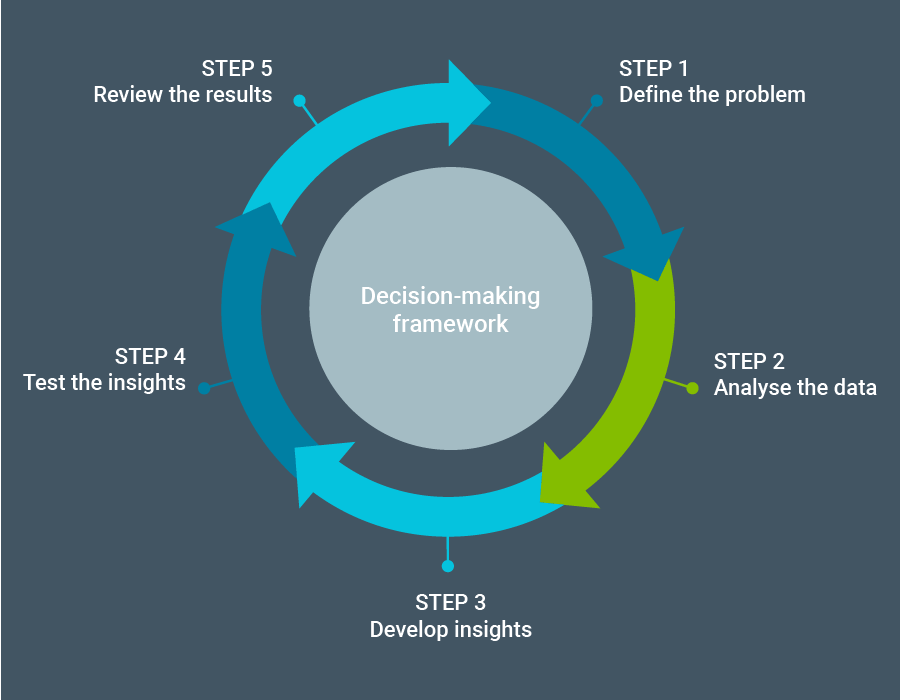Data-driven decision making is the process of collecting the data that a company uses, and transforming it into actionable insights. It is a modern business strategy that lets company staff make decisions based on facts instead of biases. Using data to find patterns, inferences, and insights ensures that your company goals and plans are based on evidence and that decisions made are balanced and objective.
Decision-making framework
The recommended way to start moving towards data-driven decisions is to compile a data catalog to understand the data landscape, and to then decide on what data can improve your decision making capability.
This helps to focus on the reasons the data is needed, how it will be used, and what value the data is expected to provide. The work to get this has to be collaborative.
The volume and quality of data is important. You don’t want data that could create analysis paralysis. The data that is selected should ensure that a desired outcome is achieved from using the data.
Building a data-driven organization is an iterative process. After the first cycle of the project, new insights will become clear as goals for the next cycle of development.

At some stage, you will start seeing what datasets opportunities there are for competitive advantage.
Level of data maturity
Data-driven decision making involves cultural change in the organization. Without this change in the business, unlocking of the value of data will be limited. There are different stages of data maturity in an organization – indifference, awareness, informed, data-driven.
While it has become a buzzword, few organizations are really unlocking value. Most businesses are at a lower stage of data maturity.
Data maturity is not just about collecting data, companies already do that in many systems. It’s also about using the right tools, platforms, and skills to unlock maximum value. Increasingly, businesses need to hire and train analysts and data scientists. But even with the right skills, without the tools they will not be able to unlock value.
Data maturity also requires encouraging employees to use data to make decisions, rather than using subjective ideas. To achieve this, training that is focused on data literacy is important.
A data mature business is able to use data to make a decision, and then justify that decision from the data.
Where to get the data in the manufacturing supply chain
Depending on the company, the industry, and the market conditions, different priorities will be made for which business functions have the most important data, such as:
- Inventory management and planning
- Production planning and scheduling
For example, inventory data can be collected to help:
- Knowing when to reorder to prevent stock-outs and optimize cash flow.
- Identifying fast-moving products and removing slow sellers, ensuring you stock what customers want.
- Optimizing warehouse layout for better picking and storage efficiency.
If production metrics are important, you may want to get data on:
- Machine and labor availability.
- Lead times for receiving raw materials.
- Machine performance and downtime.
- Defect rates for quality management.
How to apply metrics
One challenge is deciding what metrics to use. Different departments have their own data needs and very specific metrics. There needs to be an understanding of how granular the metrics should be. This will be directed by business goals. But it will be difficult initially to drill down to very detailed metrics until several cycles of the data-driven projects have occurred.
Value of an ERP system for data-driven decision making
If an organization is making good use of its ERP system, it can use that as a data catalog. The second step would be to establish a data dictionary based on the data objects and their respective relationships. It is a critical part of data-driven decision making as it prevents misunderstandings and inconsistencies. The ERP system as a primary data source is valuable for analysts so they can find out what a data item means and where to get it.
The ERP system also becomes one of the main systems of record. Data may be enhanced by mapping it with other systems to creating a more comprehensive data source for data-driven decision making. This ensures consistency as well as data integrity.
Data-driven strategies
The most effective strategies for providing data-driven decisions should focus on the business value of the data, how it is used within the functions of the organization, and the culture that promotes the use of data. The process of getting to a data-driven business is not a one-off project. It requires an open-minded and evolving view of how the company can implement the process, technology and people adaptations that will allow data to generate meaningful business results.



